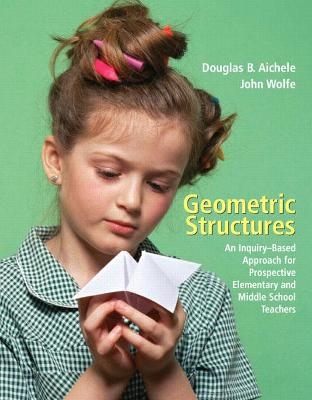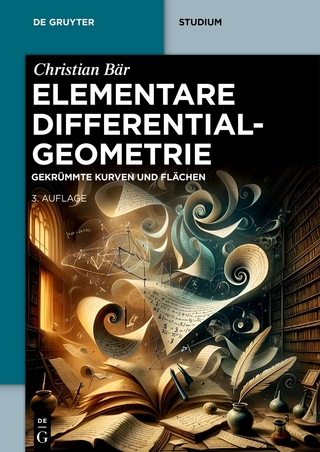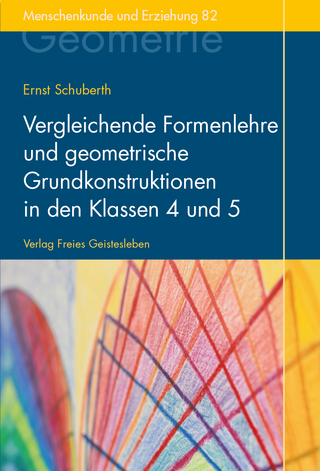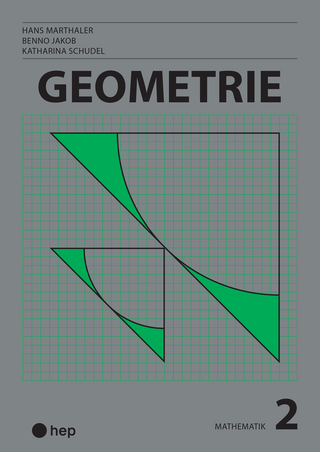
Geometric Structures
Pearson (Verlag)
978-0-13-148392-7 (ISBN)
John Wolfe, Oklahoma State University: John recently was promoted to professor emeritus at Oklahoma State University. After graduating from the University of California at Berkeley in 1971 he was active in mathematics research including several publications and National Science Foundation research grants in Banach Space Theory. His enthusiasm for teaching has been recognized by awards from both the Mathematical Association of America and the Regents of Oklahoma State University. Over the past several years educational issues with a special passion for geometry have been the focus of his professional life. Woodworking, travel, camping and grandkids are becoming increasingly important in his life. Douglas B. Aichele, Oklahoma State University: Douglas grew up in Great Neck, NY. He received his undergraduate and graduate education in mathematics at the University of Missouri-Columbia. He has been a faculty member at Oklahoma State University for many years and was appointed Regents Professor in 1989. He is currently serving as Associate Head of the Department of Mathematics. Good teaching of mathematics has always been important to him and he has been recognized over the years by such institutions/organizations as the OSU Blue Key Alumni Association, Mathematical Association of America, and the University of Missouri-Columbia.His other interests reside mainly in the outdoors - particularly spending time with his family in the mountains of Colorado at a log cabin that he built by hand. He is an avid backpacker and hiker; he has climbed most of Colorado's Fourteeners (mountains with elevations greater then 14,000 ft.) and several mountains and glaciers near Juneau, Alaska.
Part I: Paper Folding
Chapter 0 - Warm Up Activities
0.0 Introduction
0.1 Folding Polygons from a Circle
0.2 Making Squares
0.3 Two Congruent Halves
0.4 Dissecting Figures
Chapter 1 - Polygons and the Angle Relationships
1.0 Introduction
1.1 Parallel Line Grid - Triangle Angle Sum
1.2 Envelope Fold - Triangle Angle Sum
1.3 Triangle and Quadrilateral Angle Sums by Tearing
1.4 Polygon Angle Sums: How many Triangles?
1.5 The Angles of a Polygon
1.6 When Does Erika's Idea Work?
1.7 The Greedy Triangle
1.8 Problems: Angle Sums and Angle Relationships
1.9 Four Kinds of Related Angles
1.10 Figuring Angles and Checking by Measurement
1.11 Parallel Lines: How to Recognize Them
1.12 Measuring Sides and Angles of Triangles
1.14 Convex: Different Ways to Make Sense of It
1.14a Angle Problems - Version A
1.14b Angle Problems - Version B
1.15 Angle Probems - More
1.16 How Do I Know if I Understand?
1.17 Conjecturing ABout Quadrilaterals
1.18 Possible or Not?
1.19 True or False (with Example)
1.20 Under What Conditions?
Chapter 2 - Quadrilaterals and Their Definitions
2.0 Introduction
2.1 Checking Properties of Quadrilaterals
2.2 Properties of Quadrilaterals
2.3 Marking Quadrilateral Properties
2.4 Properties of Diagonals of Quadrilaterals
2.5 Checking Quadrilaterals by Folding
2.6 Read Carefully: Every Word Counts!
2.7 Checking Examples Visually or Physically
2.8 Exploring Medial Quadrilaterals
2.9a Problems: Properties of Quadrilaterals, Version A
2.9b Problems: Properties of Quadrilaterals, Version B
2.10 More Problems: Properties of Quadrilaterals
2.11 A Deeper Understanding of Definitions
2.12 Special Cases of Quadrilaterals
2.13 Definitions: Inclusive or Exclusive
2.14 Problems: Inclusive and Exclusive Definitions
2.15 What Is a Kite? Equivalent Definitions
2.16a Problems: Definitions of Quadrilaterals, Version A
2.16b Problems: Definitions of Quadrilaterals, Version B
2.17 More Problems: Definitions of Quadrilaterals
2.18 How Do I Know if I Understand?
Prologue:
Four Contexts for Geometric Constructions
Prologue to Chapters 3, 10, 12, and 14
Chapter 3 - Constructions by Paper Folding
3.0 Introduction
3.1 Introducing CDs: Two Basic Constructions
3.2 CD Problem: A Parallel Line
3.3 CD Problem: The Median
3.4 CD Problem: An Equilateral Triangle
3.5 CD Problem: A Square
3.6 Circumscribing Circle
3.7 Inscribed Circle
3.8 Balance Point of a Triangle
3.9 Additional CD Problems Using Basic Construction Steps
3.10 Group Problem: Inscribed Circles
3.11 Folding a Six-Pointed Star or a "Snowflake"
3.12 Problems Involving Paper Folding
3.13 How Do I Know if I Understand?
Chapter 4 - Explorations in Three-dimensional Geometry
4.0 Introduction
4.1 Polyhedra (Solids) from an Envelope
4.2 Roll-and-Fold Prism and Pyramid Activities
4.3 Net Project A: Prisms
4.4 Prisms
4.5 Makiing Sense of Volume: A Basic Relationship
4.6 Net Project B: Pyramids
4.7 Pyramids
4.8 Edges, Faces, and Vertices of Polyhedra
4.9 Special Kinds of Polyhedra
4.10 Riddles with Solids
4.11 Volumes Prisms, Pyramids, and Spheres
4.12 Volume of a Pyramid
4.13 What Does Volume Really Mean?
4.14 Volume of Solids: First Try
4.15a Solid-Geometry Problems, Version A
4.15b Solid-Geometry Problems, Version B
4.16 More Solid-Geometry Problems
Addendum:
Unit Origami: An Introduction
4.17 Instructions for the Basic Parallelogram Unit
4.18 Project for the Whole Class: Monster Stellated Icosahedron
4.19 Unit Origami Projects
4.20 Some Geometry of Unit Origami
4.21 Convex Deltahedra: How Many Are There?
4.22 Problems: Unit Origami
4.23 How Do I Know if I Understand?
Part2 GeoBoards and Dot Paper
Chapter 5 - Area
5.0 Introduction
5.1 How Much Space in a Triangle?
5.2 Areas on a Geoboard
5.3 Two Ways: Cut-up and Take-away
5.4 Areas: Parallelograms and Trapezoids
5.5 Area by Julie's Way
5.6 Which Ways Work for These Figures?
5.7 Areas: How Many Ways?
5.8 Area Problems: First Try
5.9 A Sampling of Area Problems
5.10 Making Sense of Common Units for Length and Area
5.11a Area Problems, Version A
5.11b Area Problems, Version B
5.12 More Area Problems
5.13 How Do I Know if I Understand?
Chapter 6 - Explorations with Geoboard Areas
6.0 Introduction
6.1 Areas of Skew Quadrilaterals
6.2 Solid Tile Shapes
6.3 Problems: Tile Shapes
6.4 Areas of Tile Shapes
6.5 Areas by Counting Pets
6.6 How Many Tile Shapes with Five Squares?
6.7 Counting Areas: Pick's Formula
6.8 Skew Figures
6.9 Discovering, Describing, and Using Relationships
6.10 Sean's Idea: Area = Inside Pegs
6.11a Problems: Geoboard Areas, Version A
6.11b Problems: Geoboard Areas, Version B
6.12 More Problems: Geoboard Areas
6.13 How Do I Know if I Understand?
Chapter 7 - Similarity and Slope
7.0 Introduction
7.1 Slope or Steepness
7.2 Slope: Parallel and Perpendicular
7.3 Slope Problems, Part 1
7.4 Slope Problems, Part 2
7.5 Linear Equations, Tables of Values, and Slopes
7.6 Similar Figures and Their Properties
7.7 Similar Figures and Proportionality
7.8 Measuring Proportionality
7.9 Reasoning withSimilar Triangles
7.10 Similarity and Scale Factors (Length Factors)
7.11 Scaling, Areas, and Area Factors
7.12 Scaling Problems, First Try
7.13 Scaling Problems
7.14 Scaling and Volume of Solids
7.15a Problems: Slope, Similarity, and Scaling, Version A
7.15b Problems: Slope, Similarity, and Scaling, Version B
7.16 More Problems onSlope, Similarity, and Scaling
7.17 How Do I Know if I Understand?
Chapter 8 - Pythagorean Theorem and Perimeter
8.0 Introduction
8.1 RightTriangles of Squares
8.2 Pythagorean Puzzles
8.3 Estimating Perimeters on a Geoboard
8.4 Slant Lengths on a Geoboard
8.5 Geoboard Perimeters
8.6 Three Special Triangles
8.7 Pythagorean Problems, First Try
8.8a Perimeter and Right-Triangle Problems, Version A
8.8b Perimeter and Right-Triangle Problems, Version B
8.9 More Perimeter and Right-Triangle Problems
8.10 How Do I Know if I Understand?
Chapter 9 - Geometry of Circles
9.0 Introduction
9.1 Perimeter (Circumference) of a Circle
9.2 Area of a Circle
9.3 Area and Perimeter of Circles and Sectors
9.4 Area Problems with Circles, First Try
9.5 Problems: Area and Perimeter of Circles
9.6 Inscribed Angles of Arcs of Circles
9.7 The Law of Thales
9.8 Circumscribed or Cyclic Polygons
9.9 Circumscribing Circle for a Cyclic Quadrilateral
9.10 Problems: Inscribed Angles and Circumscribed Polygons
9.11a Problems: Geometry of Circles Version A
9.11b Problems: Geometry of Circles, Version B
9.12 Revisiting Volumes: Cones and Cylinders
9.13 Surface Area of an Orange
9.14 More Problems: Geometry of Circles
9.15 How Do I Know if I Understand?
Part 3 - Straightedge and Compass
Chapter 10 - Straightedge and Compass Constructions
10.0 Introduction
10.1 Basic Straightedge and Compass Constructions
10.2 Straightedge and Compass: Construct a Parallel Line
10.3 Examples: Reasoning in Construction Problems
10.4 Reasoning in Construction Problems
10.5 Making Triangles, I:Side-Side-Side
10.6 Making Triangles, II: Side-Angle-Side
10.7 Making Triangles, III: Angle-Side-Angle
10.8 Making Triangles, IV: Side-Side-Angle (Ambiguous Case)
10.9 Congruence Conditions for Triangles
10.10 How Do I Know I Understand?
Chapter 11 - Congruence Conditions and Reasoning from Definitions to Properties
11.0 Introduction
11.1 Congruence Conditions for Triangles and CPCT
11.2 Problems:Congruence Conditions and CPCT
11.3 Justifications by Congruence Conditions
11.4a Problems: Congruence Conditions, Version A
11.4b Problems: Congruence Conditions, Version B
11.5 More Problems: Congruence Conditions
11.6 FromDefinitions to Properties: Five-Step Reasoning
11.7 Example: Five-Step Reasoning, Problem A
11.8 Five Step reasoning, First Try
11.9 More Problems Using Five-Step Reasoning
11.10 How Do I Know if I Understand?
Part 4 - Computer Constructions and Explorations
Chapter 12 - Computer Constructions
12.0 Introduction
12.1 Getting Started with Computer Construction Software
12.2 Constructing Objects: Midpoints
12.3 Constructing Objects: Bisectors
12.4 Constructing Objects: Altitudes and Medians
12.5 The Euler Line of a Triangle
12.6 The Nine-point Circle of a Triangle
12.7 The Medial Quadrilateral of Quadrilateral
12.8 Problems: Investigating Relationships by Using Geometric Properties
12.9 How Do I Know if I Understand?
Chapter 13 - Computer Explorations
13.0 Introduction
13.1 Triangle Inequalities
13.2 Angle Bisectors: Why the Incenter Works
13.3 Perpendicular Bisectors: Why the Circumcenter Works
13.4 Medians and the Centroid of a Triangle
13.5 Altitudes: The Orthic Triangle
13.6 Angle Bisectors, Medians, and Altitudes: Some Relationships
13.7 Revisiting the Medial Triangle: Perimeter and Area
13.8 Revisiting the Medial Quadrilateral: Area
13.9 Quadrilaterals and Circles
13.10 Circles: Central Angles and Inscribed Angles
13.11 Circles: More on Inscribed Angles and Arcs
13.12 Problems: Investigating Relationships by Using Number Ideas
13.13 How Do I Know if I Understand?
Part 5 - Mira (Reflecta) and Tracing Paper
Chapter 14 - Mira Contructions
14.0 Introduction
14.1 The Mira: What Does it Mean?
14.2 Reflection Lines and Point-Image Segments
14.3 Constructions with a Mira (CDs)
14.4 Altitudes of a Triangle
14.5 Altitudes, Orthocenters, and Trapezoids
14.6 Altitude Constructions with a Mira
14.7 Measuring a Triangle's Three Altitudes
14.8 Where is the Circumcenter?
14.9 How Do I Know if I Understand?
Chapter 15 - Symmetry
15.0 Introduction
15.1 Miniproject: Fold-andCut Paper Figures
15.2 Fold-and-Cut (Symmetric) Shapes
15.3 Orientation: One or Two Sides?
15.4a Problems: Symmetry, Version A
15.4b Problems: Symmetry, Version B
15.5 Fold and Cut: Three Symmetry Lines
15.6 Fold and Cut: Fivefold Symmetry
15.7 Problems: More on Symmetry
15.8 How Do I Know if I Understand?
Chapter 16 - The Four Symmetries
16.0 Introduction
16.1 Four Actions: Slide, Flip, Turn, and Glide-Flip
16.2 Four Symmetries
16.3 Translations and Coordinates
16.4 Problems: Four Actions or Symmetries
16.5 Combinatons of Reflections
16.6 Actions: Which of the Four Types?
16.7 Rotations and Glide-Reflections: Point-Image Segments
16.8 How Do You Get from One to the Other?
16.9 CD Problem: Find the Center of Rotation
16.10 CD Problem: Find the Glide-Reflection Line
16.11 An Experiment with the Four-Kinds Principle
16.12 Marking Symmetries on Wallpaper Designs
16.13a Problems: Four Types of Symmetry, Version A
16.13b Problems:Four Types of Symmetry, Version B
16.14 More Problems Involving the Four Types of Symmetry
16.15 How Do I Know if I Understand?
Prologue: Symmetries of Decorative Art
Prologue to Chaptes 17, 18, and 19
Chapter 17 - Symmetries of Mandalas
17.0 Introduction
17.1 Symmetries of Mandalas
17.2 Classifying Mandalas, First Try
17.3 Classifying Mandalas
17.4 Mandalas: One or Two Sides?
17.5 Template Design Mandalas
17.6 Template Design Problems
17.7 Express Yourself with a Mandala
17.8 The Symmetry Classification of Mandalas
17.9 Problems: Mandalas
17.10a Problems: Mandalas, Version A
17.10b Problems: Mandalas, Version B
17.11 How Do I Know if I Understand?
Chapter 18 - Symmetries of Borders
18.0 Introduction
18.1 Glide-Reflectional and Half-turn Symmetry
18.2 Classifying Borders, First Try
18.3 Borders: What Is Their Symmetry Type?
18.4 Generating Borders
18.5 Borders: Make Your Own Display
18.6 The Symmetry Classificaton of Borders
18.7 Problems Classifying Borders
18.8a Problems: Borders, Version A
18.8b Problems: Borders, Version B
18.9 How Do I Know if I Understand?
Chapter 19 - Escher-Style Tessellations
19.0 Introduction
19.1 Escher Tessellations, Type TTTT
19.2 How to Make a Type TTTT Tessellation
19.3 Cut and Tape: Make Your Own Tessellating Shape
19.4 Miniproject: Recognizability
19.5 Four Moves for Tessellating Squares
19.6 What Are the Possible Heesch Types?
19.7 What is the Heesch Type?
19.8 Project: Making Escher-Style Tessellations
19.9 Checking Understanding of Heesch Types
19.10 Marking Symmetries on Escher Tessellations
19.11 Do These Tessellations Work?
19.12 How Do I Know if I Understand?
Appendices
A.1 A Guide for You, the Student: Making Sense of Geometry in an Inquiry-based Class
A.2 GeoSET Website: Internet Resources for Students
A.3 Construct/Describe Problems
A3.1 Hints for Doing CD Problems
A3.2 Shorthand Comments for CD Problems
A3.3 Catalogue of CD Problems
A.4 Dot Paper Template for Copying
Bibliography
Index
| Erscheint lt. Verlag | 18.4.2007 |
|---|---|
| Sprache | englisch |
| Maße | 100 x 100 mm |
| Gewicht | 100 g |
| Themenwelt | Mathematik / Informatik ► Mathematik ► Geometrie / Topologie |
| Sozialwissenschaften ► Pädagogik ► Schulpädagogik / Grundschule | |
| ISBN-10 | 0-13-148392-7 / 0131483927 |
| ISBN-13 | 978-0-13-148392-7 / 9780131483927 |
| Zustand | Neuware |
| Haben Sie eine Frage zum Produkt? |
aus dem Bereich


